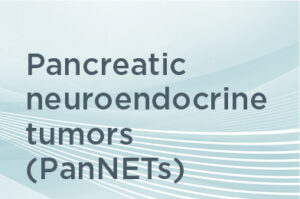By Anna Greene, PhD, NETRF Director of Research
 Pancreatic neuroendocrine tumors (PanNETs) are rare and tricky. Some grow slowly and never cause trouble, while others spread quickly and become life-threatening. Doctors have long known that certain genetic changes, like mutations in the ATRX or DAXX genes, are linked to worse outcomes. But many aggressive tumors don’t have those mutations, leaving doctors without clear warning signs.
Pancreatic neuroendocrine tumors (PanNETs) are rare and tricky. Some grow slowly and never cause trouble, while others spread quickly and become life-threatening. Doctors have long known that certain genetic changes, like mutations in the ATRX or DAXX genes, are linked to worse outcomes. But many aggressive tumors don’t have those mutations, leaving doctors without clear warning signs.
A NETRF-funded study by Aatur Singhi, MD, PhD published recently has uncovered another important genetic signal: BEND2 fusion genes. And it could change how we predict and manage high-risk cases.
What Are BEND2 Fusion Genes?
Genes are like blueprints for building proteins. Sometimes, two different genes can get accidentally “fused” together in cancer cells, creating a hybrid that behaves differently than either gene alone. This new research found that in a small but significant group of pancreatic neuroendocrine tumors, the BEND2 gene was fused with other genes like CHD7 or EWSR1.
These fusions seem to rewire how tumor cells control their DNA structure and how they maintain their chromosome ends (telomeres), changes that can fuel aggressive growth.
Who Is Affected?
In this study, researchers examined tumors from 73 patients with non-functional PanNETs (meaning the tumors don’t produce excess hormones). They found:
- About 7% had BEND2 fusion genes.
- All BEND2 fusion-positive tumors fell into a molecular “cluster” with aggressive features—larger size, higher grade, and a tendency to spread.
- The patients with these tumors were mostly younger women.
When they expanded the study to a much larger group of 539 tumors, about 3% were BEND2-positive overall, but the rate jumped to 9% in tumors that had already spread.
Why It Matters
BEND2-positive tumors were linked to much worse survival:
- Only 13% of patients remained disease-free three years after surgery, compared to 90% for BEND2-negative tumors.
- Just 25% were alive five years after diagnosis, versus 90% for those without BEND2 changes.
Even after accounting for tumor size, grade, and other factors, BEND2 status remained an independent predictor of poor outcome.
A New Way to Identify High-Risk Patients
One benefit of this discovery is that BEND2 expression can be detected with a standard lab test (immunohistochemistry), which many pathology labs already perform. This means that, in the future, testing for BEND2 could be included in routine tumor evaluation, assisting doctors in identifying high-risk patients earlier.
Importantly, BEND2 fusions never appeared alongside ATRX/DAXX mutations, so testing for all three genes could catch more high-risk tumors than testing for ATRX/DAXX alone.
What’s Next?
While BEND2 fusions are rare, they are powerful markers of aggressive disease. This study suggests that combining BEND2, ATRX, and DAXX testing could give doctors a more complete picture of which tumors are most dangerous and guide decisions about surgery, follow-up, and possible clinical trials.
For patients and families, this is another step toward personalized care for neuroendocrine tumors. The more we understand the genetic “fingerprints” of these cancers, the better we can predict their behavior and fight them more effectively.
At NETRF, we’re committed to funding and sharing research that turns discoveries like this into better outcomes for patients. We’re working toward a future where every neuroendocrine cancer patient receives a treatment plan tailored to their disease’s unique biology. Consider making a gift to help us achieve breakthroughs today, cures tomorrow.
